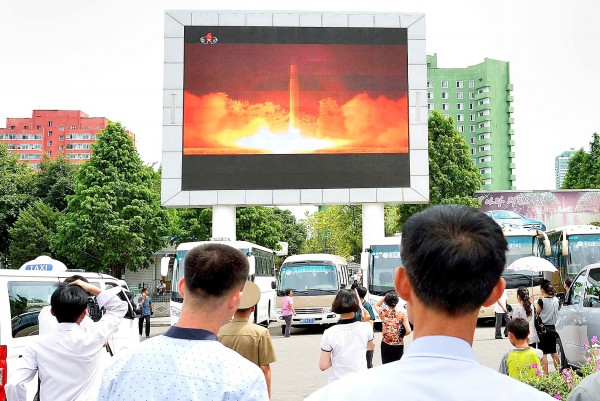《TAIPEI TIMES》 Kim says ICBMs can reach all of US

People watch news report showing North Korea’s Hwasong-14 missile launch on electronic screen at Pyongyang station, North Korea in this photo taken by Kyodo on Saturday. Photo: Reuters
‘SERIOUS WARNING’: KCNA quoted the North Korean leader as saying that the nation was capable of firing at ‘random regions and locations at random times’
/ AP, PYONGYANG
North Korean leader Kim Jong-un yesterday said a second flight test of an intercontinental ballistic missile (ICBM) demonstrated that his country can hit the continental US, hours after the launch left analysts concluding that a wide swath of the US, including Los Angeles and Chicago, is now in range of North Korean weapons.
Kim expressed “great satisfaction” after the Hwasong-14 missile reached a maximum height of 3,725km and traveled 998km before accurately landing in waters off Japan, the North’s state-run Korean Central News Agency (KCNA) said.
The test was aimed at confirming the maximum range and other technical aspects of the missile, KCNA said, adding that the missile was capable of delivering a “large-sized, heavy nuclear warhead.”
Analysts had estimated that the North’s first ICBM test on July 4 could have reached Alaska, and said that the latest missile appeared to extend that range significantly.
Japanese Chief Cabinet Secretary Yoshihide Suga said the missile, launched late on Friday night, flew for about 45 minutes — about five minutes longer than the first.
The missile was launched on a very high trajectory, which limited the distance it traveled, and landed west of Hokkaido, he added.
KCNA quoted Kim as saying that the launch reaffirmed the reliability of the country’s ICBM system and an ability to fire at “random regions and locations at random times” with the “entire” continental US now within range.
The test confirmed important features of the missile system, such as the proper separation of the warhead and controlling its movement and detonation after atmospheric re-entry, KCNA said.
The launch sent a “serious warning” to the US, which has been “meaninglessly blowing its trumpet” with threats of war and stronger sanctions, the news agency quoted Kim as saying.
North Korean flight data was similar to assessments by the US, South Korea and Japan.
David Wright, a physicist and codirector of the global security program at the Union of Concerned Scientists, said that if reports of the missile’s maximum altitude and flight time are correct, it would have a theoretical range of at least 10,400km.
That means it could have reached Los Angeles, Chicago or Denver, Colorado, depending on variables such as the size and weight of the warhead that would be carried atop such a missile in an actual attack.
US President Donald Trump issued a statement condemning the missile test as a threat to the world, rejecting North Korea’s claim that nuclear weapons ensure its security.
“In reality, they have the opposite effect,” he said.
The weapons and tests “further isolate North Korea, weaken its economy, and deprive its people,” Trump said.
Trump vowed to “take all necessary steps” to ensure the security of the US and its allies.
Japanese Minister of Foreign Affairs Fumio Kishida said he told US Secretary of State Rex Tillerson by telephone that the second missile test greatly increased the threat from Pyongyang.
He said two sides agreed to consider all means necessary to exert the utmost pressure on North Korea.
They reiterated calls for new sanctions and to work closely together with South Korea along with efforts by China and Russia.
Washington and its allies have watched with growing concern as Pyongyang has made significant progress toward its goal of having all of the US within range of its missiles to counter what it labels as US aggression.
There are other hurdles, including building nuclear warheads to fit on those missiles and ensuring reliability.
However, many analysts have been surprised by how quickly Kim has developed North Korea’s nuclear and missile programs, despite several rounds of UN Security Council sanctions that have squeezed the impoverished country’s economy.
新聞來源:TAIPEI TIMES

















